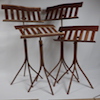I'm building a sled for my table saw, and adding a piece of plywood cut as a right triangle for miter cuts. It will attach when needed via star knobs to the kreg track I put on the sled.
My goal is to cut a perfect right triangle for this attachment. Running through it in my head, I can easily square the 90 corner on my sled, but I can't figure how to accurately cut the hypotenuse. I've done the 5 cut method to test the sled and it is square to .002 over a 20" cut, so I'd like to get the miter attachment highly accurate also .
Yes, I can cut it easily with a miter gauge, but I'm looking for a tip to make the 45s perfect. I want to be able to cut any miter from either side of the jig, not have to keep track of which piece was cut on which side in order to cancel out any error in the jig. I can't see a way to cut the hypotenuse to where the right angle legs are the same length within a few thousandths.
This is the exact sled I am working on. I was considering using William Ng's method of cutting the miter base, but that would change the design, and I want to learn a new trick if anyone has one. Thank you for any help




 Reply With Quote
Reply With Quote



